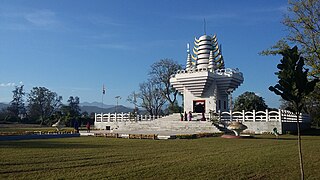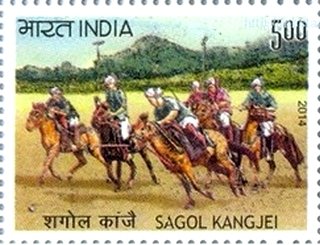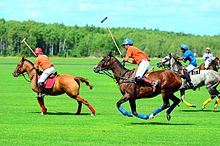
Polo or Chovgan is a ball game that is played on horseback, a traditional field sport and one of the world's oldest known team sports. It originated in ancient Persia, dating back over 2,000 years. Initially played by Persian nobility as a training exercise for cavalry units, polo eventually spread to other parts of the world. The game is played by two opposing teams with the objective of scoring using a long-handled wooden mallet to hit a small hard ball through the opposing team's goal. Each team has four mounted riders, and the game usually lasts one to two hours, divided into periods called chukkas or chukkers.

Manipur is a state in northeast India, with the city of Imphal as its capital. It is bounded by the Indian states of Nagaland to the north, Mizoram to the south and Assam to the west. It also borders two regions of Myanmar, Sagaing Region to the east and Chin State to the south. The state covers an area of 22,327 km2 (8,621 sq mi). The official and most widely spoken language is the Meitei language. Native to the Meitei people, it is also used as a lingua franca by smaller communities, who speak a variety of other Tibeto-Burman languages. Manipur has been at the crossroads of Asian economic and cultural exchange for more than 2,500 years. This exchange connects the Indian subcontinent and Central Asia to Southeast Asia, East Asia, Siberia, regions in the Arctic, Micronesia and Polynesia enabling migration of people, cultures and religions.
Yubi lakpi is a seven-a-side traditional football game played in Manipur, India, using a coconut, which has some notable similarities to rugby. Despite these similarities, the name is not related to the game of rugby or Rugby School in England, it is in fact of Meitei-Pangal origin, and means literally "coconut snatching". Emma Levine, an English writer on little known Asian sports, speculates:

India is the birthplace of modern polo. The modern game of polo is derived from Manipur, where the game was known as sagol kangjei, kanjai-bazee, or pulu. It was the anglicised form of the last, referring to the wooden ball that was used, which was adopted by the sport in its slow spread to the west.
Khong kangjei, also known as foot hockey, Manipuri hockey or hockey on foot, is a sport similar to field hockey primarily of the state of Manipur in India. It is a game which requires stamina, speed, and agility, and is one of the most popular games in Manipur. It is one of the indigenous sports of Manipur, others being sagol kanjei and kang, each of which reflects the martial tradition of Manipur, and with mukna captures an ethical code important to the culture of Manipur.
Hiyangthang is a town in Indian state of Manipur. It is best known for the Hiyangthang Lairembi Temple, a Meitei shrine dedicated to ancient Meitei goddess Irai Leima. It is located in Imphal West district.
Tingkao Ragwang Chapriak (TRC) is one of the two traditional religions followed by the Zeliangrong people of Assam, Manipur and Nagaland states in North Eastern India. It is a polytheistic religion based on the fundamental belief of Tingkao Ragwang, the supreme god or almighty and other smaller brotherly gods.
The Hiyangthang Lairembi Temple is an ancient temple of Goddess Hiyangthang Lairembi of Meitei religion (Sanamahism). The sacred building is situated on the hilltop of Heibok Ching in the Hiyangthang, Manipur. Thousands of devotees thronged at the holy site during the festival time of Lai Haraoba of Sanamahism as well as Durga Puja of Hinduism.

Irai Leima is a goddess in Sanamahism, the indigenous religion of Manipur. She is the goddess and the divine female personification of water and aquatic life. She is the consort of Irai Ningthou. Both are regarded as the divine spirits of water bodies. She is also considered to be in charge of diseases.

Nongpok Ningthou, also known as the Sovereign of the East or King of the East, is a deity in Sanamahism, the indigenous religion of Manipur. He is the ruling guardian deity of the eastern direction. Legend says Nongpok Ningthou and his consort Panthoibi were united in the Nongmaiching Ching mountains. Later, they were worshipped as the civilization giving deities in Meitei religion.

The Manipur State Museum is an institution displaying a collection of artistic, cultural, historical and scientific artefacts and relics in Imphal, Manipur, India. It has galleries housing materials of natural history, ethnology and archeology.

Khoriphaba is a God in Sanamahism, the indigenous religion of Manipur. He is the son of Sky God Salailen and the Goddess Konthoujam Tampha Lairembi. He came down from heaven to earth to search for his mother and then for a bride. He is best known for wrestling with Loyalakpa in the Lai Haraoba festival. He is also a Sagol Kangjei(polo)-playing God.

Dragons play a significant role in the legendary accounts of Meitei folklore, Meitei literature, Meitei mythology and Meitei religion (Sanamahism) of Ancient Kangleipak, Medieval Kangleipak and Modern Kangleipak.

Marjing is the God of horses, polo, hockey, sports and war in Sanamahism, the indigenous religion of Manipur. The guardianship of the north eastern direction is alluded to Marjing and the other directions to Koupalu, Thangching and Wangpulen. According to the legend, he invented the game of polo and introduced it as the national game. He and his divine creature, Samadon Ayangba, reside in the top of the Heingang Ching.

The Manung Kangjeibung is an old polo field located to the south west of the citadel inside the Kangla Fort in Imphal West district of Manipur. In ancient times, only royalties and nobilities were allowed to play the game of polo in this royal playground. It is one of the two most ancient pologrounds in the world, the other one being the Mapal Kangjeibung .

The ancient legend of Ura Naha Khongjomba and Pidonnu is an epic cycle of incarnations of Meitei mythology and folklore from the Moirang kingdom of Ancient Kangleipak. It concerns the love and adventures of the forgotten prince Ura Naha Khongjomba for the beautiful woman Pidonnu.

The Marjing Polo Statue is a colossal classical equestrian statue of a player of Sagol Kangjei, riding a Meitei horse, constructed at the Marjing Polo Complex, the sacred sports site dedicated to God Marjing, the ancient Meitei deity of polo and horses, in Heingang, Imphal East District, Kangleipak . It is the world's tallest statue of a polo player. It is built to commemorate the game of "modern polo" being originated from Kangleipak.

The culture of Meitei civilization evolved over thousands of years, beginning in Ancient Kangleipak, continuing most notably into Medieval Kangleipak, while influencing the neighboring states and kingdoms, till present times.
Ningthou Kangba was a ruler of Ancient Kangleipak. He is traditionally seen as having invented Sagol Kangjei, the earliest form of the modern day polo sports. He was the son of King Tangja Leela Pakhangba (1445 BC-1405 BC) and Queen Sinbee Leima. He was the consort of Queen Leima Taritnu, daughter of a king named Nongpok Ningthou of the Nongmaiching Hill in the east of Imphal.

Sagol Kangjei is a traditional Meitei ball sport played on horseback with a long-handled stick. The sport, also known as Manipuri polo, is a predecessor of modern international polo.












